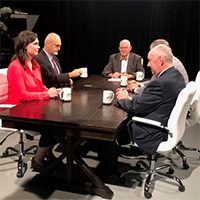North Carolinians still concerned about inflation, but consumer sentiment may be improving
Published October 17, 2024

Inflation is still on the minds of North Carolinians interviewed for the latest High Point University Poll. Half (52%) of North Carolina residents responding to the survey said inflation concerns have affected a lot of their spending decisions this year. About one-third (30%) said inflation concerns have affected some of their spending decisions, and 15% said inflation concerns haven’t affected them much at all.
North Carolinians were also asked to consider how the prices they are currently paying for products compared to last year. The majority said prices are much higher for meat (55%), and about half (50%) said they are paying a much higher price for eggs. Less than half of the poll respondents said they are paying a much higher price for electricity for their houses (42%), fruits and vegetables (42%), gas for their cars (41%), milk (40%), bread (39%), clothing (34%), electronics (36%), natural gas for their houses (30%) and water (30%).
Nearly half (48%) of North Carolina residents said the inflation over the past few months had been worse than they expected. Just one-third (30%) said inflation has been about as they expected, and only 17% said the inflation has been not as bad as expected.
“When we say inflation has fallen, we don’t necessarily mean prices have fallen, only that prices aren’t increasing quite as fast,” said Brandon M. Dragone, economics instructor in HPU’s Earl N. Phillips School of Business. “So if you remember what prices were like a couple of years ago, you might still feel the sting of inflation even with a low inflation rate. Unfortunately, the past has told us that often the only way to see prices actually fall is during recessions.”
Consumer Sentiment Low, But May Be Increasing
According to this latest poll, the Consumer Sentiment Index shows that North Carolinians’ opinions about the economy and their personal finances remain steady, recorded at 70.2. That number hasn’t changed much from when the HPU Poll last reported an index of 69.2 in the May 2024 survey. But this is the first time the index has been at or above 70 since February 2021.
The HPU Poll’s measure of consumer sentiment is an index that comprises five separate questions asking respondents about different aspects of how they view the U.S. economy and their own personal finances.
North Carolina Residents – Prices Currently Paying (October 2024)
Thinking about the prices you are currently paying for products on this list compared to last year, would you say prices are much higher, somewhat higher, about the same as last year, somewhat lower or much lower? [Items presented in a random order]
| Much higher price | Somewhat higher price | About the same | Somewhat lower | Much lower | Unsure or don’t buy | |
| Meat | 55 | 28 | 11 | 2 | 1 | 3 |
| Eggs | 50 | 28 | 14 | 4 | 1 | 4 |
| Electricity for your house | 42 | 34 | 16 | 3 | 1 | 4 |
| Fruits and vegetables | 42 | 34 | 17 | 2 | 2 | 3 |
| Gas for your car | 41 | 26 | 16 | 10 | 3 | 5 |
| Milk | 40 | 33 | 19 | 3 | 1 | 4 |
| Bread | 39 | 35 | 19 | 2 | 1 | 4 |
| Electronics | 36 | 31 | 19 | 2 | 2 | 11 |
| Clothing | 34 | 34 | 23 | 2 | 2 | 6 |
| Natural gas for your house | 30 | 21 | 16 | 3 | 1 | 29 |
| Water | 30 | 29 | 28 | 3 | 1 | 9 |
North Carolina Residents – Inflation and Spending Decisions (September 2024)
How much have concerns about inflation affected major spending decisions you have made this year?
A lot – 52%
Some – 30%
Not much at all – 15%
Unsure – 4%
North Carolina Residents – Inflation Expectations (September 2024)
Generally speaking, has the inflation we have seen over the past few months been worse than you expected, not as bad as you expected or about what you expected?
Worse than expected – 48%
Not as bad as expected – 17%
About as expected – 30%
Unsure – 4%
September 2024 Consumer Sentiment Index Results:
We are interested in how people are getting along financially these days. Would you say that you (and your family living there) are better off or worse off financially than you were a year ago?
Better off – 20%
Worse off – 48%
Same/Neither – 29%
Unsure – 3%
Now looking ahead, do you think that a year from now you (and your family living there) will be better off financially, or worse off, or just about the same as now.
Better off – 32%
Worse off – 21%
About the same – 31%
Unsure – 17%
Now turning to business conditions in the country as a whole, do you think that during the next 12 months we’ll have good times financially, or bad times, or what?
Good times – 20%
Bad times – 22%
Neither – 29%
Good times with qualifications – 11%
Bad times with qualifications – 5%
Unsure – 14%
Looking ahead, which would you say is more likely, that in the country as a whole we’ll have continuous good times during the next five years or so, or that we have periods of widespread unemployment or depression, or what?
Widespread unemployment or depression – 19%
Continuous good times – 19%
Neither – 11%
Mix of both – 39%
Unsure – 12%
About the big things people buy for their homes, such as furniture, a refrigerator, stove, television, and things like that. Generally speaking, do you think now is a good time or bad time for people to buy major household items?
Good time – 20%
Bad time – 40%
Neither good time nor bad time – 30%
Unsure – 9%
HPU Poll 106 was fielded by the High Point University Survey Research Center on Sept. 20 through Sept. 29, as an online survey using a panel of respondents recruited and maintained by Dynata. Dynata sent invitations to its panel of North Carolina respondents and the SRC collected 1,001 responses (an all-adults sample) on its Qualtrics platform. All respondents were asked two screening questions to identify them as registered voters. A total of 814 respondents identified themselves as registered voters. The SRC did all data analysis. The online sample is from a panel of respondents, and their participation does not adhere to usual assumptions associated with random selection.
In this case, for the all-adults sample, the SRC provides a credibility interval of plus or minus 3.2 percentage points to account for a traditional 95% confidence interval for the estimates







